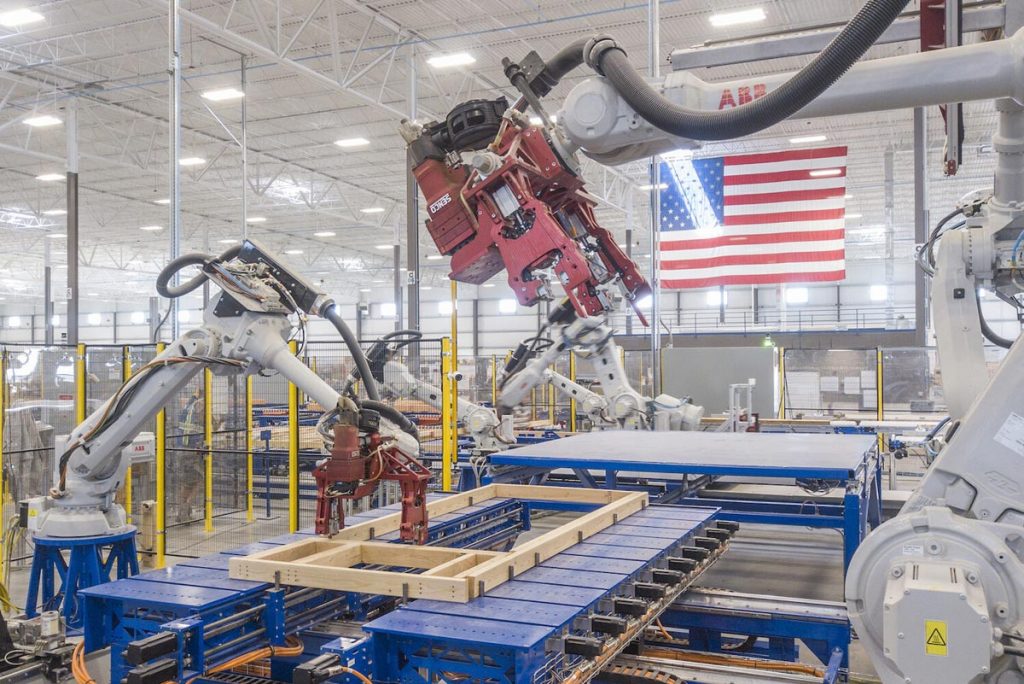Sign up to the Built Offsite Newsletter

Modular construction company Autovol completes installation of robotic systems
Driven by the philosophy of supplying the market with affordable modular homes, Autovol, based in Idaho, US, have implemented a comprehensive automated modular-build process which it refers to as “automated volumetric modular construction” (robotic systems automate modular housing construction).
The system uses robotic systems to assemble six-sided modules and configures them with all appliances, fixtures, and MEP systems for delivery to the job site, where they are installed. Utilities are connected and exterior cladding affixed onsite.
Their build process differs from other panelised modular construction, where walls, floors, and ceiling panels are factory manufactured and then assembled on site. The Autovol system breaks down the structure into cubic modules— from two studio apartments across the hall from each other, to several building blocks forming a two- or three-bedroom unit—to construct a multi-story building.
The walls can be up to 22 metres in length and 3 metres in height.

ABOVE: Autovol’s robotic production line.

ABOVE: Complete Autovol volumetric modular two-studio apartment and production line.
They opened their 37,000 sqm plant in July 2020, and equipped it with 53 ABB six-axis industrial robots, which fully automate the production of the walls, ceilings, and floors that make up the volumetric modules.
Autovol co-founder and CEO Rick Murdock, who has been in the manufactured housing industry for 44 years—he co-founded Guerdon Modular Buildings—said he got “hooked on automation” after attending a trade show a few years ago. “I formed this vision of starting a robotically automated modular housing plant that could build a high-quality product while relieving construction workers and tradespeople of the physical stress common to the job.”
To design the factory, engineers used RobotStudio, ABB’s offline simulation and programming software, to experiment with highly realistic simulations of automation systems, featuring numerous robot models and layout combinations, to reach the optimal design for each robotics line.
The software is able to select and position the line components, such as conveyors and robot tracks, that perform the various manufacturing processes. Interestingly, the software can identify potential bottlenecks and calculate accurate space requirements and throughput metrics that the system concept would deliver if actually installed on the plant floor. In effect, end-users are able to experiment with system design variations through risk-free trial and error until the ideal system is designed.
From this design process robotic construction lines occupy the core of the US$104 million Autovol plant. Surrounding the robotic construction line is where the walls, floors, and ceilings are assembled into the modules, and where the MEP systems are installed, the walls are painted. The modules are further equipped with appliances and bathroom fixtures.

ABOVE: Installation of Autovol volumetric modular units.
On reflection, Murdock admits that shipping panels might be less costly than shipping completed prefabricated modules, but “the biggest bang for the buck is to get something delivered on site that is as close to finished as possible.” With panels, “the materials need to be unloaded and organized, and you almost need the same crew on site as if you were stick building.” That makes up for the additional cost of shipping finished modules.
Murdock said his ultimate goal is to expand geographically. “The vision was never for one plant,” he said. “It was for many.”
See: autovol.com
See: new.abb.com/products/robotics/robotstudio
CLICK HERE to return to the home page for more articles.